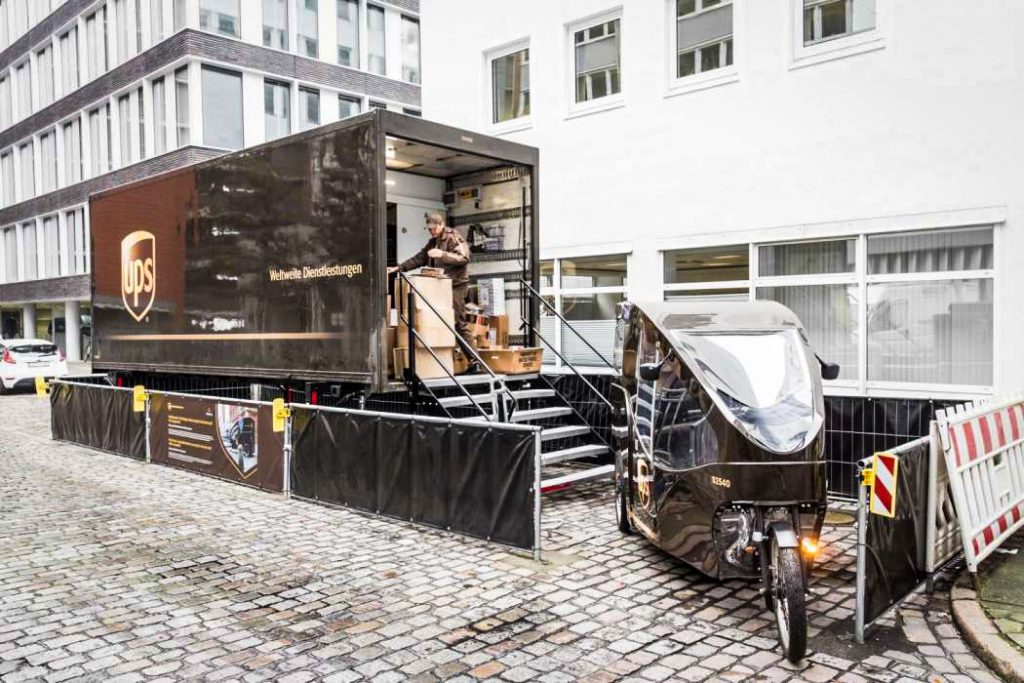“We don’t need another empirical study on micro hubs. We have run enough trials – now is the time to act.” Rainer Kiehl, Project Manager for City Logistics at UPS Hamburg, is convinced that with today’s knowledge, every package delivery company would theoretically be able to introduce zero-emission logistics right away. The solutions are there – and micro hubs are certainly one of them. In an interview, Rainer Kiehl shed some light on how UPS Hamburg delivers goods via these urban hubs.
Efforts to Decarbonize the Last Mile
While the last mile is by far the most expensive part of the delivery process (depending on the study, it amounts to 40 or even 50 % of all transportation related costs), it is also the part of the process that is most visible to the end customer and therefore vital for businesses. That being said, shifting to sustainable delivery processes certainly pays off in more than just one way.
According to Rainer Kiehl, Project Manager for City Logistics at UPS Hamburg, Germany, numerous efforts have been made throughout the last years to make delivery on the last mile more sustainable by increasing the share of zero-emission vehicles.
The early introduction of cargo bikes is such an effort. However, back in 2005, these bikes were used solely for deliveries in pedestrian zones and due to their limited number, the real impact remained negligible. Since 2007, UPS has also been pushing electric vehicles for their deliveries. Not only did they purchase the first electric vans, but they also found a German company to convert already existing trucks with internal combustion engines into fully electric vehicles.
Still, one thing remained unsolved. Whether fully electric or with internal combustion engine, both types of vehicles need to be parked somewhere. And this process of finding available parking in dense urban areas is extremely time consuming and therefore expensive for a delivery company too.
It was time for a different approach to last mile delivery – one that made it possible to deliver large volumes with environmentally friendly vehicles and at the same time solved the parking issue.
Introducing Micro Hubs – the Hamburg Model
In 2015, UPS started trialling a new concept for sustainable package delivery in the city centre: micro hubs. Together with the City of Hamburg, four different locations within the inner city were chosen to set up mini distribution centres that would enable the use of zero-emission vehicles on the last mile.
The concept itself is rather simple: Each morning, four fully loaded trucks (>7.5 t) with swap bodies – basically storage containers (20 m2) with consolidated shipments – are driven to four different locations in the city centre, where they get decoupled and parked for the rest of the day. From the inside, the containers resemble a standard delivery van from UPS which allows for quicker orientation.
The delivery on the last mile is then carried out by two or three deliverymen, depending on the parcel volume of the day. In several tours, the packages are transported to their final address in an environmentally sustainable way either via cargo bike, tricycle, or simply on foot with the help of an (electrically assisted) handcart.
Rainer Kiehl explains that this model also works for return deliveries and scheduled parcel collections – also known as the first mile. Due to the limited storage space of cargo bikes, however, these are done in separate tours.

Lessons Learned From Hamburg.
Micro hubs in combination with cargo bikes, trikes and handcarts have one major benefit: time spent on the search for a parking space is reduced to zero. Because in comparison to a delivery van, cargo bikes can be parked in about no time.
Ultimately, there are three main lessons learned from the Hamburg model:
1. Regulatory Restrictions.
“One of the major stumbling blocks and number 1° reason why micro hubs are not yet operated city-wide, is the difficulty of finding the space”, argues Rainer Kiehl.
First, free space is scarce and fiercely contested in city centres. Secondly, what is needed to set up a micro hub on a parking space in Hamburg, is a special-use permit and the payment of a monthly fee. Since there is currently not one single person responsible for logistics in the City of Hamburg – no designated “City Logistics Manager” – it can take time, patience and persistence until a special-use permit that allows a logistics company to set up a micro hub is issued.
Furthermore, such a permit can be withdrawn again, which shows that this is no more than a temporary solution that provides no real planning security. What UPS is really aiming for are permanent solutions that allow for long-term planning.
Lesson No. 1: What is needed are clear responsibilities, a political agenda and the will to support companies in finding permanent solutions for sustainable deliveries.
2. Hardware Challenges.
The suitability of cargo bikes for inner city areas is undisputed. Still, there are some aspects to consider when planning a micro hub in combination with cargo bikes.
First of all, service area and customer density are critical factors. Making sure that even the most remote customer is located in a cyclable distance from the hub is essential for the success of a micro hub. According to Rainer Kiehl, the maximum radius around a hub would be 1.5 to 2 km. In regard to customer density, the settlement structure and drop rate (number of parcels delivered per stop) play an important role too. Mixed use areas are generally better suited for micro hubs than industrial areas or residential areas with a majority of single-family houses for example.
Secondly, cargo bikes can’t replace delivery vans on the last mile completely. While most of UPS’s electrically operated cargo bikes contain swappable boxes with an average storage space of 1.5 m3 to 2 m3 and a maximum payload of around 200-350 kg, Rainer Kiehl admits that considering the entire goods movement in a city, a great number of deliveries remains too heavy or too bulky for cargo bikes.
More precisely, CEP deliveries only account for 10 % and more than 50 % can be considered freight. So, even though cargo bikes can carry a standard euro palette, there will still be bigger shipments that call for a truck or van.
Lesson No. 2: Certain areas are better suited for a delivery with cargo bikes than others. Knowing the limits can prevent a company from setting up a micro hub that is never going to be economically viable nor environmentally sustainable
3. Image problems.
Rainer Kiehl knows that not everyone shares the same enthusiasm when it comes to micro hubs. Especially, when they come in the form of dark big storage containers. There were a number of people who voiced concern that the container would be a flaw in the cityscape, an eyesore, something you just don’t want to have in your street or in your neighbourhood. Also, it causes traffic – and who really wants that?
So, how to best deal with opposition? Well, most importantly – you have to listen and understand people’s concerns. UPS did that and with the help of a group of Design students, they gave their micro hubs a new look. One that made them fit in instead of standing out. The company also realised that it was important to use the opportunity to send a message and raise awareness.
The new containers show the skyline of the city and at the same time let people know that every micro hub helps to take two ordinary trucks off the streets of our city. And with that knowledge, the containers suddenly do not even seem that “ugly” anymore.
Lesson No. 3: The best way to deal with opposition is to listen to what your opponents have to say and try to understand their concerns. You never know what good can come out of that.
In a Nutshell
Setting up a micro hub and using zero-emission vehicles for the last mile delivery is a simple concept that works very well in a city, given that possible limiting factors like customer density or settlement structure are taken into account. One might also keep in mind that UPS’s micro hubs in the form of mobile containers should not be considered a permanent but rather a temporary solution.
On the regulatory side, what is needed are clear responsibilities and a political agenda that accelerate and facilitate the transition towards green deliveries. Having a direct contact person with at the city government would be a first step into the right direction.
Rainer Kiehl is aware that the Hamburg model is neither perfect nor perfectly suitable for every city around the world. Also, knowing the numbers and limitations, it’s currently impossible to have all goods delivered via a micro hub and by cargo bike.
Nevertheless, if we want to tackle the challenges of last mile delivery, it’s all about starting somewhere. There will always be room for improvement, but that doesn’t mean that it’s not worth the effort.
“The most important thing is that you do something – just start at some point!”


